View in other NatureServe Network Field Guides
NatureServe
Montana
Utah
Wyoming
Idaho
Wisconsin
British Columbia
South Carolina
Yukon
California
New York
Northern Beechfern - Phegopteris connectilis
Other Names:
Thelypteris phegopteris
State Rank Reason (see State Rank above)
Rare in Montana where it is known from the extreme northwest corner of the state to Glacier National Park. Past timber harvesting likely led to declines in the species' abundance and distribution. Invasive weeds (Orange and Meadow Hawkweeds), proposed mining activity, timber harvesting and fires all have the potential to detrimentally impact the species in the future.
- Details on Status Ranking and Review
Population Size
Score1 - Moderate: Generally 10,000-100,000 individuals.
Range Extent
Score1 - Peripheral, Disjunct or Sporadic Distribution in MT: Widespread species that is peripheral, disjunct or sporadically distributed within MT such that it occurs in <5% of the state (<7,500 sq. miles or the combined area of Beaverhead and Ravalli Counties) or is restricted to 4-5 sub-basins.
Area of Occupancy
Score1 - Moderate: Generally occurring in 11-25 Subwatersheds (6th Code HUC’s).
Environmental Specificity
Score1-2 - Moderate to High.
Trends
Score0-2 - Stable to Moderate Declines:
CommentTrend data are unavailable. Habitat generally appears to be stable and it does not appear likely that severe declines have occurred, though it is possible that minor declines have occurred or may be occuring across the species' range in Montana due to drought conditions or other factors.
Threats
Score1 - Medium: 11-30% of the populations are being negatively impacted or are likely to be impacted by one or more activities or agents, which are expected to result in decreased populations and/or habitat quality and/or quantity.
CommentPotential threats at various sites range from invasive weeds to mining activity. Timber harvesting, if was to occur at occupied sites is also likely to cause negative impacts.
Intrinsic Vulnerability
Score2 - High Vulnerability: Very specific biological attributes, unusual life history characteristics or limited reproductive potential makes the species highly susceptible to extirpation from stochastic events or other adverse impacts to its habitat and very slow to recover.
Raw Conservation Status Score
Score
7 to 10 total points scored out of a possible 19.
General Description
Northern Beechfern has leaves that are scattered along long, slender rhizomes. The leaves are 1.5-5 dm long, with about half of their length being a long, slender petiole. The blades are beset with hairs; especially ciliate hairs exist along the margins and rachis. There are 10-25 pairs of pinnae in each pinnately compound leaf. The sori are borne just inside the margins of each pinnule.
Phenology
Producing spores late in season; August or September.
Diagnostic Characteristics
Distinguished from most other ferns with uniform, non-evergreen fronds greater than 10 cm by scattered rather than densely tufted fronds, and by the distinctly hairy blade margins and midveins rather than glabrous or chaffy ones. There are many fern species which are difficult to identify from each other. A technical key should be consulted.
Species Range
Montana Range
Range Descriptions
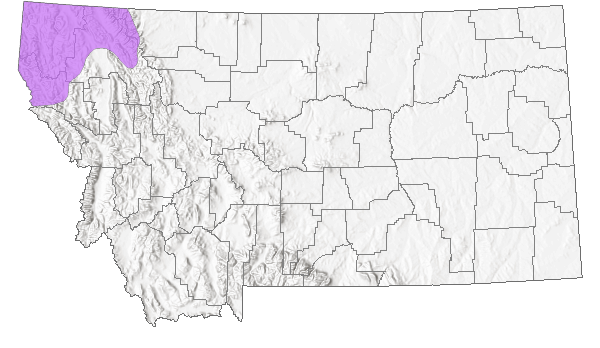
 Native
Native
Range Comments
In MT in Lincoln, Flathead and Glacier counties; AK to Greenland south to OR, MT, SK, MO, and VA (Lesica et al. 2012. Manual of Montana Vascular Plants. BRIT Press. Fort Worth, TX).
Observations in Montana Natural Heritage Program Database
Number of Observations: 46
(Click on the following maps and charts to see full sized version)
Map Help and Descriptions
Relative Density
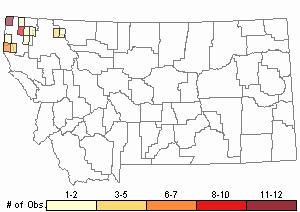
Recency
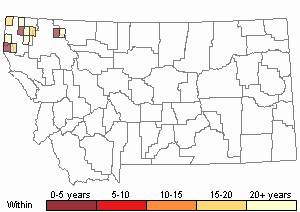
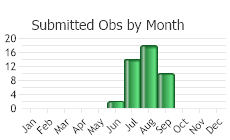
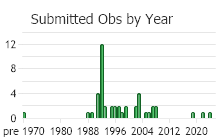
 (Observations spanning multiple months or years are excluded from time charts)
(Observations spanning multiple months or years are excluded from time charts)
Habitat
Mesic, western redcedar forests and shaded cliffs in the valley to subalpine zones.
Ecological Systems Associated with this Species
Stewardship Responsibility
Threats or Limiting Factors
STATE THREAT SCORE REASON
Reported threats to Montana's populations of Northern Beechfern include impacts from exotic species and potential displacement by mining activity (MTNHP Threat Assessment 2021). Orange and Meadow Hawkweed (Hieracium aurantiacum and Hieracium caespitosum) populations surround many populations and are tolerant of shady habitat required by Northern Beechfern. Mining activity also poses a range of risks to some populations.
References
- Literature Cited AboveLegend:
 View Online Publication
View Online Publication Lesica, P., M.T. Lavin, and P.F. Stickney. 2012. Manual of Montana Vascular Plants. Fort Worth, TX: BRIT Press. viii + 771 p.
Lesica, P., M.T. Lavin, and P.F. Stickney. 2012. Manual of Montana Vascular Plants. Fort Worth, TX: BRIT Press. viii + 771 p. MTNHP Threat Assessment. 2021. State Threat Score Assignment and Assessment of Reported Threats from 2006 to 2021 for State-listed Vascular Plants. Botany Program, Montana Natural Heritage Program, Helena, Montana.
MTNHP Threat Assessment. 2021. State Threat Score Assignment and Assessment of Reported Threats from 2006 to 2021 for State-listed Vascular Plants. Botany Program, Montana Natural Heritage Program, Helena, Montana.
- Additional ReferencesLegend:
 View Online Publication
View Online Publication
Do you know of a citation we're missing? Kuennen, L. J., and D. Leavell. 1993. Conservation assessment: Thelypteris phegopteris. U.S.D.A. Forest Service, Kootenai National Forest, Libby, MT.
Kuennen, L. J., and D. Leavell. 1993. Conservation assessment: Thelypteris phegopteris. U.S.D.A. Forest Service, Kootenai National Forest, Libby, MT. Leavell, D.M. 1993. Conservation assessment of Thelypteris phegopteris. Unpublished report of Kootenai National Forest, Libby, Montana. 13 pp. plus appendices.
Leavell, D.M. 1993. Conservation assessment of Thelypteris phegopteris. Unpublished report of Kootenai National Forest, Libby, Montana. 13 pp. plus appendices. Lesica, P., M.T. Lavin, and P.F. Stickney. 2022. Manual of Montana Vascular Plants, Second Edition. Fort Worth, TX: BRIT Press. viii + 779 p.
Lesica, P., M.T. Lavin, and P.F. Stickney. 2022. Manual of Montana Vascular Plants, Second Edition. Fort Worth, TX: BRIT Press. viii + 779 p. McLaughin, W. T. 1935. Notes on the flora of Glacier National Park, Montana. Rhodora 37:362-365.
McLaughin, W. T. 1935. Notes on the flora of Glacier National Park, Montana. Rhodora 37:362-365.
- Web Search Engines for Articles on "Northern Beechfern"





